Japan Advanced Institute of Science and Technology. School of Knowledge Science, Umemoto Lab.
Managing Existing Knowledge is Not Enough:
Knowledge Management Theory and Practice in Japan
1. Introduction
The 1990s has witnessed a remarkable surge of interest in knowledge as the ultimate source of competitive advantage not only for business companies but also for nations or regions (Toffler 1990; Drucker 1993). And knowledge management (KM) has become a most lucrative industry in itself, which is evidenced by scores of KM books being sold worldwide, KM programs being promoted by consulting firms, and KM software being marketed by IT vendors.
Professor Ikujiro Nonaka, dubbed “Mr Knowledge” by the Economist magazine (May 31, 1997 issue), is one of the most influential thinker in the KM movement since he published the now-classic Harvard Business Review article titled “the Knowledge-Creating Company” (Nonaka 1991), which was later enlarged and enriched into another article (Nonaka 1994) and a book with the same title (Nonaka and Takeuchi 1995).
Knowledge management in Japan has naturally been influenced by ProfessorNonaka. Though KM goes usually by its Japanese pronunciationナレッジ・マネジメント, it can be translated into two Japanese terms, namely 知識管理 (chishiki kanri) and知識経営 (chishiki keiei). While the former means only management of existing knowledge, the latter term, promulgated by Nonaka and Konno(1999), goes beyond it to further imply “management by creating new knowledge continuously.” According to this view, current IT-based KM practices, though its impressive diffusion, still remains at the former level.
Being dissatisfied with it, Professor Nonaka and his colleagues have continued their efforts to further develop his theory of organizational knowledge creation as the basis of 知識経営 (chishiki keiei) (Nonaka, Umemoto, and Senoo 1996; von Krogh, Nonaka, and Ichijo 1997; Nonaka and Konnno 1998; Nonaka and Konno 1999; Nomura and Kamezu 1999; Nonaka, Toyama, and Nagata 2000; von Krogh, Ichijo, and Nonaka 2000; Nonaka, Reinmoeller, and Senoo 2000; Nonaka, Toyama, and Konno 2000; Nonaka, Reinmoeller, and Toyama, forthcoming). This paper aims to provide the reader with the recent theoretical developments and current Japanese KM practices in Japan.
2. Recent Developments in KM Theory and Practice in Japan
As of 2000, Nonaka's theory of organizational knowledge creation consists of four major elements:
(1) the SECI model, the process of creating new knowledge through interaction and conversion between tacit and explicit knowledge (see the previous chapter); (2) ba or a shared context for knowledge creation; (3) knowledge assets as inputs and outputs of the knowledge-creating process; and(4) knowledge leadership that provides enabling conditions conducive to the process. These four elements interact with each other in “management by creating new knowledge continuously.”
Because no single company can represent the all aspects of Nonaka's theory, we present mini-cases that are practicing each of the four elements: i.e., the SECI model, ba, knowledge assets, and knowledge leadership, respectively. Needless to say, however, practice cannot be the same as theory. In reality, therefore, Japanese companies to be presented below have adapted, with varying degrees, the four elements.
2.1. SECI as the Self-Transcending Process
Since the SECI model is discussed in the previous chapter, this section presents only notable points and developments to deepen your understanding of the model. First, the knowledge-creating process takes the form of spiral, not a circle. In the “knowledge spiral,” the interaction between tacit and explicit knowledge is amplified through the four modes of knowledge conversion. The spiral becomes larger in scale as it enriches knowledge contents and moves up the ontological levels from individual to group to organizational (and often to inter-organizational), and then back into the individual level. It is a dynamic, never-ending process, starting at the individual level and expanding as it moves through communities of interaction that transcend individual, sectional, departmental, divisional, and organizational boundaries (see Figure 1).
Second, knowledge creation is the self-transcending process that an individual finds his or her new identity, first within a group, and next in an organization, thereby discovering him- or herself enriched with new experienceand knowledge. In socialization, individuals acquire skills by sharing direct (i.e., real) experiences with others in the same time and space, like in apprenticeship or OJT, and empathize another person's way of looking at the same situation by “putting oneself into another person's shoes.” In externalization, those empathized but separate tacit knowledge such as individuals'mental models get integrated into a group's mental model, which is then articulated into explicit concepts through dialogues. In combination, new explicit concepts created by the group are combined with existing explicit knowledge (e.g., component technologies) to form a systemic knowledge (e.g., a new product and/or service) at the organizational level. And in internalization, again, individuals (e.g., factory workers, service engineers, customers) accumulate tacit knowledge of know-how by producing, doing, or using the product and/or service.
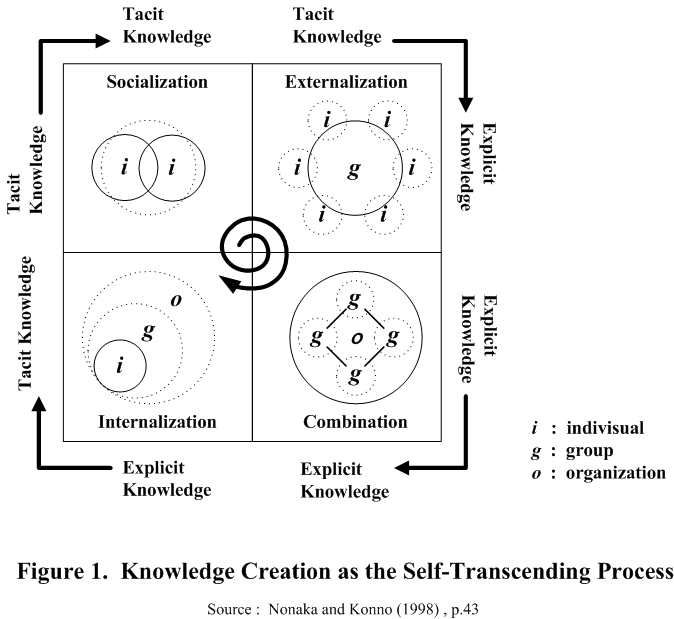
2.2. Practicing an Elaborated SECI model at Fuji Xerox
Fuji Xerox has defined its mission as “Build an Environment for the Creation and Effective Utilization of Knowledge.” The leading copier-maker has developed an intranet-based knowledge-sharing system called “Z-EIS or Zen-in Engineering Information System” (Zen-in means everyone) and built a “Zen-in Design Room” or a meeting room where designers and engineers come together from every stage of the development process to have discussion over three-dimensional, visualized drawings.
The development of the knowledge-sharing and -creating systems started in the early 1990s when the company's R&D managers decided to solve the problem of prolonged lead time due to design changes in the last stage of development. Engineers responsible for the last stage, who are also closer to users, had to wait for a prototype. To solve the problem, therefore, designers and engineers of the whole development process had interacted with one another to have discussions in search of solutions. They noticed the importance of know-how or tacit, on-the-site knowledge of designers and engineers, which often becomes explicit only in front of prototypes. Thus, they started visiting each site of development stage and trying to capture the tacit, on-the-site knowledge (Socialization).
In the meantime, they came up with the concept of “Zen-in Design” or “Design by Everyone,” which means that “every engineer must participate in the whole design process by making comments or suggestions for better designs while taking responsibility in each area. Yet, a problem of how to organize the captured knowledge remained. To that purpose, an on-line engineering information-sharing system was developed and named as Z-EIS, into which designers and engineers started articulating and inputting (i.e., formalizing) their on-the-site know-how (Externalization).
Because not every piece of formalized knowledge is good enough to be shared among all designers and engineers, middle managers of each development stage have to identify only usable items to be officially registered on the Z-EIS. In addition to the on-the-site know-how, three-dimensional graphical models, parts specifications, market data, patents information, and product management data are input into the Z-EIS. Thus, 4,500 know-how of articulated on-the-site knowledge are shared among 500 designers and 4,100 engineers, and about 50,000 inquiries come to the Z-EIS every month, as of 1999 (Combination).
For the registered items of know-how to become really significant, they must be actually utilized and lead to action. To effectively and efficiently utilize the articulated know-how, therefore, most useful knowledge are selected and compiled into the “quality assurance list,” i.e., new explicit knowledge to be utilized for design reviews. Thus, the explicit knowledge of design and development know-how are utilized and adapted on the site, thereby becoming tacit again (Internalization).
As noted above, the SECI process is not a cycle but a spiral. Therefore,the knowledge-creating process goes on, entering into socialization again. Designers and engineers with enriched and embodied tacit knowledge come together and interact with one another at the Zen-in Design Room. Nomura and Kametsu (1999) pointed out that currently prevalent KM practice of utilizing merely existing knowledge forms the cycle of actions from formalizing to selecting, thereby contributing to some increase in efficiency, but little in creativity in organizations (see Figure 2).
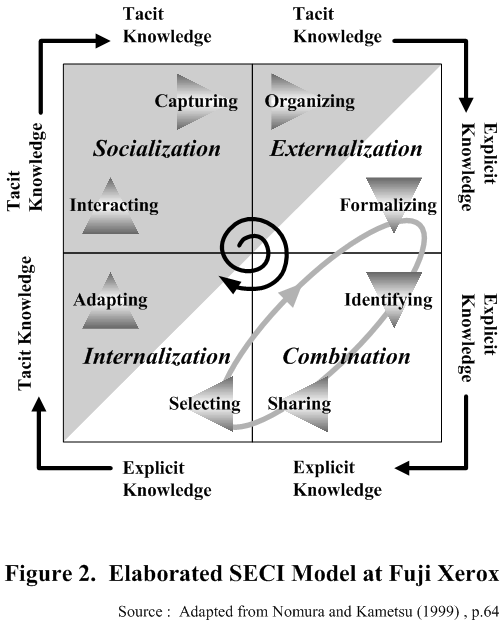
2.3.Ba: Shared Context for Knowledge Creation
Nonaka and Konno (1998) introduced the concept of ba to the KM field. They defined it as “a shared context in which knowledge is created, shared, and utilized.” Ba can be physical (e.g., office), virtual (e.g., teleconference), mental (e.g., shared experiences, ideas, or ideals), or any combination of them.
For knowledge to be created, it needs a context. Contrary to the Cartesian view of knowledge that asserts the absolute and context-free nature of knowledge, the knowledge-creating process is necessarily context-specific. Social, cultural, and historical contexts provide the basis for us to interpret information and create meaning. Ba is a context where information is interpreted and integrated into knowledge. Also, ba provides platforms and energy for individuals to participate in each mode of knowledge conversion and to move along the knowledge spiral.
A key concept in understanding ba is interaction. Knowledge is created through interactions among individuals or between individuals and their environments, rather than by an individual operating alone. Interactions may be real or virtual (i.e., IT-based) or a mix of them. Especially in socialization and externalization, it is essential for participants to interact face-to-face in the same time and space (i.e., in a real ba), because these modes deal with tacit knowledge that is difficult to be transmitted via electronic media (Nonaka, Umemoto, Senoo 1997). Ba is the context shared by those who interact with each other, and through such interactions, participants and ba itself co-evolve through self-transcendence and knowledge creation.
There are four types of ba: i.e., originating ba, dialoguing ba, systemizing ba, and exercising ba, each of which corresponds roughly to socialization, externalization, combination, and internalization, respectively.
Originating ba is defined by real, face-to-face interactions. It is a place where individuals share experiences, cognitions, and emotions. It offers mainly a context for socialization, since real, face-to-face interaction is the only way to capture the full range of physical senses and psycho-emotional reactions such as ease or discomfort, which are important elements in sharing tacit knowledge. Originating ba is an existential place in the sense that it is the world where an individual transcends the boundary between self and others by empathizing with others. From originating ba emerge care, love, trust, and commitment, which form the foundation for knowledge conversion among individuals.
Dialoguing ba is defined by collective, face-to-face interactions. It is the place where individuals'mental models are shared, translated into common language, and articulated into concepts through dialogues among participants. Therefore, dialoguing ba offers mainly a context for externalization. Also, the articulated knowledge goes back into each individual, interacts with the remaining tacit knowledge, thereby promoting further articulation through reflection. Dialoguing ba can be built more intentionally than originating ba. When possible, selecting individuals who have the right mix of specific knowledge and capabilities is the key to promoting knowledge creation in dialoguing ba.
Systemizing ba is defined by collective, indirect (i.e., increasingly virtual or IT-based) interactions. It offers mainly a context for combination of existing explicit knowledge, which can be easily transmitted to a large number of people in written form. IT (e.g., TV conference, intranet, groupware, and the Internet) offers a virtual collaborative environment for the building of systemizing ba. Today, many organizations use such media as electronic mailing lists and news groups through which participants can exchange necessary information or answer each other's questions to collect and disseminate knowledge and information efficiently as well as effectively.
Exercising ba is defined by interactions between explicit knowledge and actions. It offers mainly a context for internalization. By acting on explicit knowledge, which is communicated through such media as text manuals, video manuals, simulation programs, and any combination of them, individuals embody it into tacit operational knowledge. In other words, individuals learn explicit knowledge by actually or virtually doing it. In exercising ba, action initiates individual reflection and then enables individual transcendence, while in dialoguing ba thought starts collective reflection and then enables collective transcendence (For more discussion, see Nonaka and Konno 1998; Nonaka, Toyama, and Konno 2000).
2.4. Forming Ba at NTT East
The Business Communications Headquarters (BCH) of NTT East, a local telecommunications services provider in the Eastern part of Japan, is notable for its innovative KM program that combines a real ba (i.e., an original office layout) and a virtual ba (i.e., numerous intranet-based homepages built by every individual, section, department, and the BCH itself) to create new knowledge of solutions for its business clients. Kunio Ushioda, executive deputy-director of the BCH, is the father of the innovative KM program. He devised a concept called “Kaichi” or his own Japanese translation of the English term “education,” which originally means extraction of human capabilities. His idea is to extract human capabilities with the new office environment and the intranet.
Ushioda has also devised another concept “creation by cross culture,” which means that new knowledge is created through unexpected encounters and dialogues among people with different knowledge and information. The new office layout is designed to form a number of real ba, thereby promoting dialogues and interactions among 1,600 BCH members with different backgrounds. Each floor has four zones as follows: “Base Zone” is used mainly for project planning and characterized by “free address” (i.e., nobody has a designated desk, instead every member has a portable phone, a notebook computer, and a castered sidebox), which facilitates the quick organizing of project teams, the sharing of skills among project members (i.e., socialization), and unusual encounters with members of other project teams by taking seats side by side.Thus, this zone is supposed to be originating ba and systemizing ba (see Figure 3).l “Creative Zone” is used for a project team to create new ideas through dialogues assisted by personal computers and a 42-inch plasma display, which are connected to the wireless LAN-based intranet that provides almost all necessary information and knowledge. This space is located by the window and partitioned by green plants that are movable to make space necessary for each meeting. This zone is supposed to be dialoguing ba (see Figure 4).l “Concentration Zone” is used for individuals to develop further ideas conceived in the “Creative Zone,” and mainly by system engineers for programming, system design, or proposal writing. This space is partitioned for individuals who want to concentrate on his or her work in a quiet environment. This zone is supposed to be systemic ba and exercising ba (see Figure 5). “Refresh Zone” includes a smoking room, a vending-machine corner, and a magazine browsing corner, and is used either for relaxation or for informal interaction and conversations among employees with different backgrounds. This zone is supposed to be originating ba (see Figure 6).
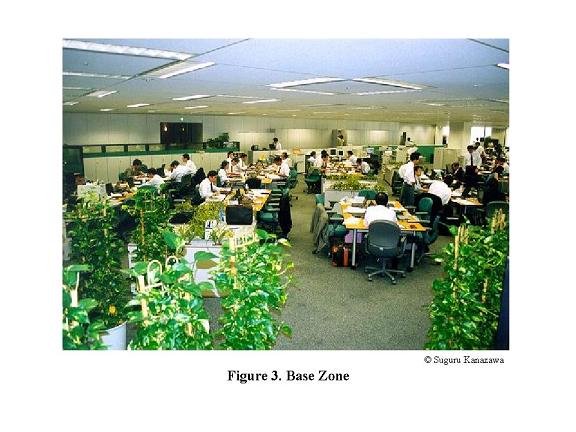
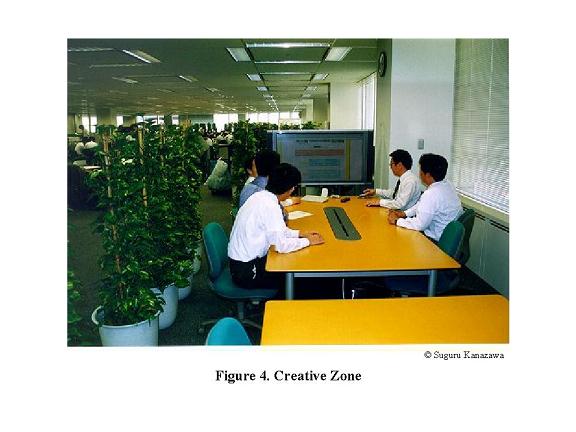
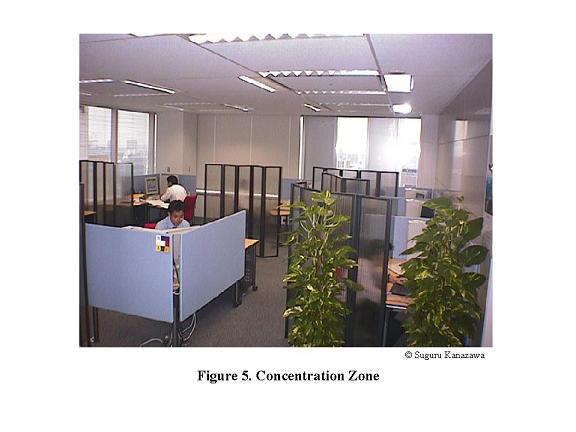
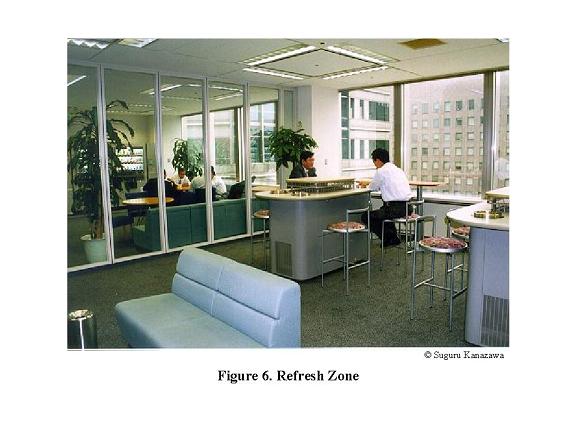
Another system designed to utilize existing knowledge and thereby to create new knowledge is numerous intranet-based homepages as virtual ba. Every member of the BCH (about 1,600) has his or her own homepage, which consists of four parts called by such metaphors as “My Home,” “Second House,” “Resort House,” and “My Study.” “My Home” self-introduces the builder of the homepage with an individual profile and a photograph (or a moving picture) plus an extension phone number, an e-mail address, etc.; “My Study” includes day-to-day work records about projects of the homepage builder, e.g., daily reports on sales negotiation, all of which are accessible to every member of the BCH and can be copied for the business use with permission; “Second House” contains work experience of the homepage builder, historiesof past projects he or she has participated in, and his or her expertise or qualifications; and “Resort House” provides information about such personal matters as hobbies and family members of the homepage builder, which is supposed to facilitate communication with strangers.
The original intention of building the personal homepages has been helping each member master basic Internet skills and know each other. Now, those personal homepages of colleagues belonging to the same project team (or others if necessary) are mutually linked for the quick access to each other's business files, thereby sharing a virtual working ba as well as information and knowledge. Thanks to a text-mining technology, moreover, members of the BCH can find any business files that contain information they want to know.
Also, each section or department has its own homepage that holds various knowledge bases. For example, the 3rd Sales Department has a knowledge base called “Forest of Knowledge,” which contains proposals and materials for presentations to business clients. The knowledge base, intended to promote the sharing of best sales know-how, works as follows:
(1) a sales manager reads daily negotiation reports and proposals his team members submit electronically;
(2) the manager selects proposals good enough to be registered with his comments on the knowledge base by clicking a registration button;
(3) the number of access to each registered proposal is counted, ranked, and shown on the first page of the knowledge base;
(4) salespersons who used the registered proposals click a “thank you” button and thenumber of “thank you” clicks is counted and shown along with the ranking; and
(5) the top two of the ranking, i.e., two of the most popular proposals are conferred the semiannual “Best Knowledge Award.”
2.5. Four Types of Knowledge Assets
Although knowledge is viewed as one of the most important assets for a firm to create a sustainable competitive advantage today, we do not have yet an effective method to measure, evaluate, or manage knowledge assets. Existing accounting systems are inadequate to capture the value of knowledge assets due to tacit and dynamic nature of some knowledge assets, though several new measures to evaluate knowledge assets or intellectual capital have been proposed (Stewart 1997; Edvinsson and Malone 1997).
Yet, to make a knowledge strategy, we need some understandings of how knowledge assets are created, accumulated, and utilized. As such an attempt, Nonaka and associates (Nonaka and Konno 1999; Nonaka, Toyama, and Konno 2000) proposed a taxonomy to categorize knowledge assets into four types as follows: (1) “experiential” knowledge assets, (2) “conceptual” knowledge assets, (3) “systemic” knowledge assets, and (4) “routine” knowledge assets.
Experiential knowledge assets are tacit knowledge that is built through shared hands-on experience among a firm's members and between them and its customers or suppliers. Skills and know-how acquired and accumulated through work experiences are examples of experiential knowledge assets. Other examples include: affective knowledge (e.g., care, love, and trust), motor knowledge (e.g., facial expressions and gestures), energic knowledge (e.g., enthusiasm and tension), and rhythmic knowledge (e.g., improvisation and entrainment). Because experiential knowledge assets are tacit, they are difficult to capture, evaluate, or exchange for money. Only through their own experiences can firms accumulate their own experiential knowledge assets. Their tacitness makes experiential knowledge assets firm-specific and difficult-to-imitate resources that provide a sustainable competitive advantage to a firm.
Conceptual knowledge assets are explicit knowledge articulated into words numbers, and diagrams. They are concepts that are held by members of a company and its customers. Examples include corporate strategies, product concepts and designs which are possessed by members of the company, and brand equity which is perceived by customers. Since they have tangible forms, conceptual knowledge assets are easier to see than experiential knowledge assets. Still it is difficult to measure customers' and organizational members' perception.
Systemic knowledge assets consist of systemized and packaged explicit knowledge. Examples are manifestly-stated technologies, product specifications, manuals, and documented and packaged information about customers or suppliers. Legally protected intellectual properties such as licenses and patents also fall into this category. Since they are most “visible” and easily digitized into IT, current knowledge management practices focus primarily on them. Also, they can be traded and transferred with relative ease. Routine knowledge assets are tacit knowledge that is embedded in organizational daily practices and actions. Examples include know-how (e.g., those in various corporate functions), organizational routines and cultures as certain patterns of thinking and action that are shared among organizational members and reinforced by daily activities. Sharing narratives and stories about their own company also helps form routine knowledge assets. Note that the routine nature may become inertia and hinder the knowledge-creating process (cf., core rigidities of Leonard-Barton 1992).
2.6. Knowledge Assets Programs at Fuji-Xerox, Hitachi, and Sony
Because the above taxonomy is new, no Japanese company has adopted it in practice yet. Increasingly, however, more and more Japanese companies have come to understand the importance of knowledge assets. Among them, it is probably Fuji Xerox that understands best what KM is, since the company is very close to Professor Nonaka. The leading copier maker has instituted several programs regarding knowledge assets. Most interesting is the program called “C-class Marketing.” C stands for CEO, COO, CKO, CIO, etc., or top managers who have decision-making power. This unique program helps Fuji-Xerox sales people get access to their potential corporate clients' decision-makers by providing them with Fuji Xerox's knowledge assets, even hard-earned wisdom from its failures, accumulated over the long time about such issues as total quality management, sales force automation, risk management, outsourcing, human resource management, and so on. Most of the knowledge assets are explicit systemic knowledge assets, which were externalized from tacit experiential knowledge assets, and are currently in use at Fuji-Xerox.
The program works as follows. A salesperson hands a sheet of paper titled “Collaboration Program” to a possible corporate customer's purchasing department. It lists up the above issues about which Fuji Xerox has accumulated and externalized knowledge. He invites the possible customer's top manager to a “presentation room” (there are now five in Tokyo, one in Osaka, and one in Nagoya), where invited top managers listen to presentations by an experts on issues they are interested in. The experts/presenters have been especially trained for this program. The presentations include Fuji Xerox's knowledge as sets as well as general knowledge about the selected issues. According to an in-house survey to Fuji-Xerox's sales people, 95 percent of them either strongly agreed or agreed to the statement: “the program has helped strengthen the trust between you and your customers,” and 88 percent of them either strongly agreed or agreed to the statement: “the program has helped your business negotiations.”
Rather than giving away its knowledge assets for free, Hitachi sells its systemic knowledge assets. When Etsuhiro Syoyama rose to president of Hitachi in 1998, he declared his vision that “we aim for the‘Knowledge Enterprise' and demonstrates its ability to synthesize its technology and intelligence.” The electronics giant has since started two knowledge assets programs. One is to sell its “systemic knowledge” that were only internally utilized until then, for example, packaged software of computer-assisted engineering (CAE), through a portal site named “i-engineering” on the Internet.
The other is a brand management program, which was instituted directly under the president in April 2000. The company has decided the “brand platform“ that shows the direction Hitachi brand aims at and a corporate statement “Inspires the Next” that symbolizes the platform. The statement means that “the company will inspire the next generation, society, product, system, or solution, thereby realizing a rich life and a good society.” Under the new brand management program, Hitachi brand is strictly managed and now 600 group companies should pay for its use. The goal of this program is to raise the image and value of Hitachi brand up to par with those of Sony.
Sony's CEO and chairman Nobuyuki Idei stated in a recent newspaper interview that the company aims for the “Knowledge-Based Manufacturer” that capitalizes on its manufacturing capability, brand power, and knowledge about consumers. The original Japanese term “chishiki seizogyo” for “Knowledge-Based Enterprise” was coined by Nonaka and Konno (1999). Sony has its own knowledge assets programs. Known as a “maverick” for a Japanese company, Sony has a unique organizational culture. It instituted an education program called “Sony Juku” for young promising employees in their thirties. Every year, top management instill “Sony spirit” as “experiential knowledge” into 16 future leaders, who in turn are required to propose strategic plans as “conceptual knowledge” to top management. This year, four strategic plans for “Sony of the Internet Age” were proposed to then president Idei, who accepted them all and ordered their immediate implementation. Sony has a tradition that respects ideas from younger employees and nurtures mavericks. Ken Kutaragi, president of Sony Computer Entertainment that now dominates the video game industry with “PlayStation,” was such a maverick.
2.7. Knowledge Leadership
The knowledge-creating process cannot be managed in the traditional sense of management that centers on controlling the flow of information. By providing several “enablers,” however, top and middle managers as knowledge leaders enable the organization to actively and dynamically create knowledge (Nonaka and Takeuchi 1995; von Krogh, Nonaka, and Ichijo 1997). Top managers as knowledge leaders should: (1) provide the knowledge vision, (2) define and redefine knowledge assets thereby keeping them relevant to the knowledge vision, (3) form, energize, and connect ba, and (4) direct, promote, and justify the SECI process (see Figure 7).
Though middle managers also do usually the above tasks, creating the knowledge vision is a responsibility of top managers. Therefore, we name middle managers as “knowledge producers.” Being strategically situated at the intersection of the vertical and horizontal flows of information in an organization, they form, nurture, and lead multiple ba in order to create new knowledge. The “middle-up-down management” (Nonaka 1988; Nonaka and Takeuchi 1995) is an example of such a “distributed leadership” that promotes the knowledge-creating process.
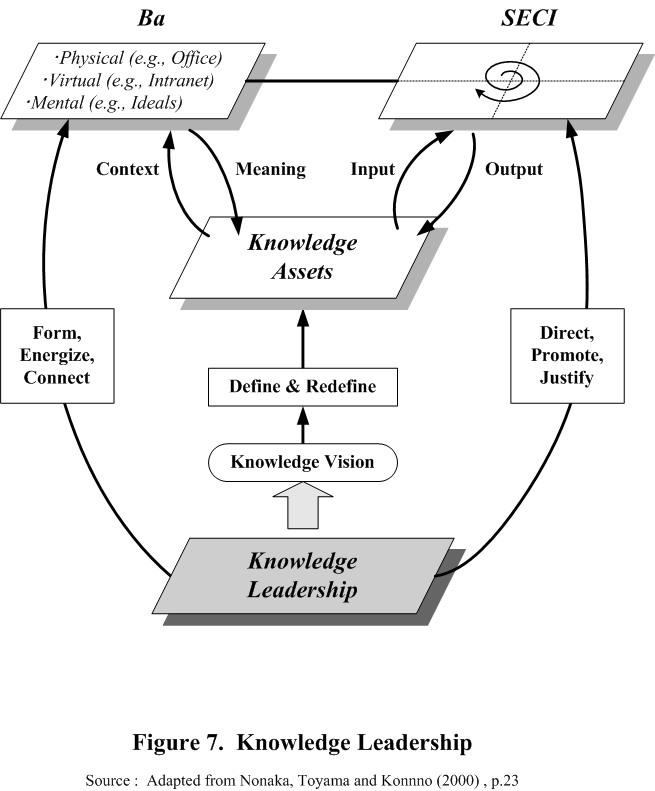
2.7.1. Providing the Knowledge Vision
To create knowledge continuously, a company needs a vision that drives, orients, and synchronizes its entire organization. It is top management who should create and disseminate a knowledge vision throughout and outside the company. The knowledge vision: (1) defines what kind of knowledge the company should create in what domain; (2) provides the company with a value system that evaluates, justifies, and determines the types and quality of knowledge it creates; (3) gives a sense of direction to the knowledge-creating process; (4) fosters spontaneous commitments of participants in the process; and (5) determines how the company and its knowledge base evolve over the long term. Because knowledge itself has no boundaries, any kind of new knowledge can be created regardless of the existing business structure of the company. Therefore, it is important for top managers to provide such a knowledge vision that transcends the boundaries of existing products, divisions, organizations, or markets. Since visions are necessarily vague by its very nature, they have to be articulated by someone. It is fine with top managers to articulate their visions by themselves if they can, but usually the responsibility of articulating the vague visions fall on middle managers, who serve as a bridge between visionary ideals at the top and chaotic realities of front-line workers at the bottom. Middle managers have to break down the knowledge vision (often expressed in an abstract grand concept) into more concrete and practical mid-range concepts that guide the day-to-day knowledge-creating activities. They also serve as “knowledge producers” and supervise the knowledge-creating operations according to the company's vision (Nonaka, Toyama, and Konno 2000).
2.7.2. Defining and Redefining Knowledge Assets
More and more companies have created the position of chief knowledge officer (CKO) to supervise KM at the corporate level. So far, however, these CKOs' role has been limited chiefly to managing the exploitation of existing knowledge assets. They have to play a leading role in making a knowledge strategy by defining and redefining what kinds of new knowledge assets are needed to realize the knowledge vision. Because knowledge has no limit and is quick to become obsolete, top managers can and should redefine what kinds of knowledge assets are now relevant for the company. For such a creative destruction, they have to (1) take an inventory of knowledge assets the company owns;and (2) on that basis, make a strategy to create, accumulate, and utilize knowledge assets effectively and efficiently. For example, to develop an environmentally-friendly car for the 21st century, Toyota studied a hybrid power system of a gasoline engine and an electric motor. The company found that it did not have yet such major component technologies as the next-generation battery, motor, converter, and inverter to build such a hybrid power system. Shocked by the lack of such important knowledge that could determine its future, top management of Toyota decided to invest heavily into research and development of the hybrid power system, which is now used in the world's first hybrid car Prius.
2.7.3. Forming, Energizing, and Connecting Ba
Ba can be built intentionally or emerges spontaneously. Top managers and knowledge producers can form ba by providing such physical space as meeting rooms, such cyber space as a computer network, or such mental space as common goals. Forming a task force is a typical example of intentional building of ba. Knowledge leaders have to choose the right mix of team members and promote interaction among them.
Also important for knowledge leaders is to find and utilize spontaneously-emerging ba, which is volatile and disappears very quickly. They have to read the situation in terms of how organization members are interacting with each other and with outside environments in order to secure a naturally-emerging ba as well as to form a ba effectively. To support such a fragile ba and drive the SECI process therein, moreover, ba should be energized by providing such enabling conditions as autonomy, creative chaos, information redundancy, requisite variety, love, care, trust, and commitment (Nonaka and Takeuchi 1995; von Krogh, Ichijyo, and Nonaka 2000).
To realize the company's knowledge vision, moreover, various ba should be connected with each other to form a greater ba. To that purpose, knowledge leaders have to facilitate interactions among various ba and among participants therein. More often than not, relationships among ba are not predetermined. To connect various ba, therefore, knowledge leaders have to read the situation as the relationships among them unfold.
2.7.4. Directing, Promoting, and Justifying the SECI Process
The most important task for top managers as knowledge leaders is to supervise (i.e., direct, promote, and justify, not control) the SECI process by checking always whether the knowledge-creating process at the corporate level is heading toward the knowledge vision and whether knowledge created in the process is justifiable according to the knowledge vision. Without controlling the process and suppressing creativity, they should occasionally provide appropriate advices to participants in the process. And when the process is in trouble, they should view the whole situation and create their own concepts to solve the fundamental problem.
Middle managers as knowledge producers capture tacit knowledge from top managers and front-line workers or from such outside constituents as customers and suppliers, and externalize it into new concepts. Directly involved in the knowledge-creating process, knowledge producers must have high ability to create new concepts and express them in their own language. Language proficiency here means communication capability to convey their mental models with a rich vocabulary, metaphorical expression, analogical reasoning, drawings as visual language, and nonverbal body language.
2.7.5. Knowledge Leadership at Eizai
Eizai, Japan's fifth largest pharmaceutical company, has practiced KM according faithfully to Nonaka's theory. When Haruo Naito assumed the position of president in 1988, the domestic pharmaceutical industry faced such challenges as lower prices of medical drugs regulated by the government, new competitors from overseas and other industries, increases in R&D costs, and more knowledgeable users. In 1989, he posed his employees a challenging question: “Society is changing, can you change yourself?” and started a corporate reform movement called “Eizai Innovation.” Under the banner of “human health care or hhc”, he also declared a new corporate vision: “Empathize with patients'emotions, put the highest priority on the increase in their benefits, and meet their various needs worldwide.” The hhc movement is divided so far into three stages. In the first stage in 1990-91, Naito himself selected 103 young employees from the R&D, production, marketing, and administrative departments, who were then trained into “core managers” to lead the hhc movement and realize the Eizai Innovation. The second stage was from 1992 to 1996. In 1992, the core managers started 74 hhc projects throughout the company toward the goal of “every employee practicing hhc everyday.” Those projects aimed to increase customers' benefits by creating knowledge or improvements of their products and customer relationships (though the company then was not aware that they were creating new knowledge).
In 1997, the hhc movement entered the third stage as president Naito set up a new office called “Chisobu” (which literally means the knowledge creation department). Now under the strong influence of Nonaka'theory, the KM office: (1) disseminate Nonaka's theory of organizational knowledge creation throughout the company via lectures and the intranet-based homepage called “Chi-no-Hiroba” (or the Knowledge Forum); (2) conduct a questionnaire survey to assess knowledge conversion capabilities (i.e., the four modes, socialization, externalization, combination, and internalization) of the company as a whole, all departments, and sections, thereby suggesting remedies for their weaknesses in knowledge creation; (3) promote the hhc movement, support the hhc projects, and disseminate their achievements; and (4) plan and implement human resource development programs to educate “knowledge workers.
Among many hhc programs, the “Chiso Conference” (or knowledge creation conference) is notable since its mission is to educate “knowledge producers.”Participants in the education program are able employees selected by president Naito himself. It consists of five parts: (1) a course designed to develop knowledge creation capabilities, especially concept-making skills; (2) another course to teach management innovation and strategic thinking; (3) a practice training at a hospital for the elderly to capture their tacit knowledge; (4) a session to present participants' proposals for management innovations; and (5) a correspondence course aimed at internalization of explicit knowledge which cannot be taught through the above courses due to time limitation.
3. Some Implications
Hansen, Nohria, and Tierney (1999) argued that there are two types of KM strategy, i.e., “codification strategy” in which “knowledge is carefully codified and stored in databases, where it can be accessed and used easily by anyone in the company,” and “personalization strategy” in which “knowledge is closely tied to the person who developed it and is shared mainly through direct person-to-person contacts” (p.107). They also argued that: (1) the choice between the two is a central issue for KM; (2) trying to pursue both at the same time may harm corporate performance; and (3) one should be adopted as main and the other as complementary.
Having observed KM practices at Japanese companies, however, we take issue with their argument, which shows a dichotomous or “either-or” thinking typical of Americans. The typology may be a false dichotomy. We argue that KM should pursue both strategy at the same time, because the two strategies, and explicit and tacit knowledge each focuses on, are complementary and equally important. Although they took McKinsey and Boston Consulting Group as examples that adopted the personalization strategy, a recent Business Week article says that both firms “deployed some of the world's most sophisticated --and expensive--internal databases.” Pursuing the both strategy are not only Japanese companies we observed but also are some European companies such as Gemini Consulting and Nokia. It seems that the IT-based or explicit knowledge-oriented KM popular in the United States and the plople-based or tacit knowledge-oriented KM extant in Japan are now converging.
With regard to this trend, Davenport and Prusak (1998)'s preface to the paperback edition (2000) argued that KM must be linked to business strategy, work processes, culture, behavior, and the physical workplace. Among them, linking KM to work processes has become increasingly easier thanks to the advancement of information and communication technology (ICT). As shown in the NTT East case, the cost of building knowledge bases has significantly decreased because day-to-day work records enter almost automatically into databases. All employees have to do is just write the usual daily reports or documents and then to their managers. Thus, IT helps us a lot to share and utilize existing knowledge. Yet the goal of KM is, as we have stated at the beginning, to create new knowledge continuously, that is (chishiki keiei). We now have to wait for more advanced IT to assist us in our knowledge creation.
References
Asakura, Reiji (2000). Revolutionaries at Sony. NewYork: McGraw-Hill.
CRM&CTI Promotion Office, NTT East (2000). Building Practical CRM. Tokyo: NTT Publishing, (in Japanese).
Drucker, P.(1993). Post-Capitalist Society. London: Butterworth Heinemann.
Edvinsson, L., and M. S. Malone (1997). Intellectual Capital. New York: Harper Business. Hansen, M.T., N. Nohria, and T. Tierney (1999). “What's Your Strategy for Managing Knowledge?” Harvard Business Review, March-April, pp.106-117.
Kanazawa, S.(2000). An Empirical Study of Ba for Knowledge Creation: A Case Study Study of NTT East's Business Communications Headquarters. Master's Thesis, Graduate School of Knowledge Science, Japan Advanced Institute of Science and Technology.
Leonard-Barton, D.(1992). “Core Capabilities and Core Rigidities: A Paradox in Managing New Product Development,” Strategic Management Journal, 13-5, pp.363-380.
Nishida, K.(1990). An Inquiry into the Good. Translated by M. Abe and C. Ives. New Haven: Yale University Press. Originally published in 1921.
Nomura, T. and A. Kametsu (1999). “A Framework for Designing Total Knowledge Management Systems,” The Annual Bulletin of Knowledge Management Society of Japan, No.1, pp.55-72, (in Japanese).
Nonaka, I.(1988). “Toward Middle-Up-Down Management: Accelerating Information Creation,” Sloan Management Review, 29-3, pp.9-18.
----------. (1990). Chishiki-Sozo no Keiei (Management by Creating Knowledge). Tokyo: Nihon Keizai Shimbun-sha, (in Japanese).
----------. (1991). “The Knowledge-Creating Company,” Harvard Business Review November-December, pp.96-104.
----------. (1994). “Dynamic Theory of Organizational Knowledge Creation," Organization Science, 5-1, pp.14-37, also in this volume.
Nonaka, I. and N. Konno (1998). “The Concept of ba: ”Building a Foundation for Knowledge Creation,” California Management Review , 40-3, pp.40-54.
------------------- (1999). Chishiki Keiei no Susume (An Introduction to Knowledge Management). Tokyo: Chikuma Shoten. (in Japanese).
Nonaka, I. and H. Takeuchi (1995). The Knowledge-Creating Company. New York: Oxford University Press.
Nonaka, I., K. Umemoto, and D. Senoo (1996). “From Information Processing to Knowledge Creation,” Technology in Society, 18-2, pp.203-218.
Nonaka, I., P. Reinmoeller, and D. Senoo (2000). “Integrated IT Systems to Capitalized on Market Knowledge,” in von Krogh, I. Nonaka, and T. Nishiguchi (eds.), Knowledge Creation: A Source of Value, London: Macmillan, pp.89-109.
Nonaka, I., and P. Reinmoeller, and R. Toyama (forthcoming). “Integrated Information Technology for Knowledge Creation.” In Dierkes, M. and et al (eds.). Hand book of Organizational Learning and Knowledge, Oxford: Oxford University Press.
Nonaka, I., R. Toyama, and N. Konno (2000).“SECI, Ba and Leadership: a Unified Model of Dynamic Knowledge Creation.”Long Range Planning, 33, pp.5-34.
Nonaka, I., R. Toyama, and A. Nagata (2000). “A Firm as a Knowledge-Creating Entity: A New Perspective on the Theory of the Firm,” Industrial and Corporate Change, 9-1, pp.1-20.
Stewart, Tom (1997). Intellectual Capital : The New Wealth of Organizations. New York: Doubleday. Toffler, A.(1990). Powershift: Knowledge, Wealth and Violence at the Edge of the 21st Century. New York: Bantam Books.
von Krogh, G., I. Nonaka, and K. Ichijo (1997). “Develop Knowledge Activists!,” European Management Journal, 15-5, pp.475-483.
von Krogh, G., I. Nonaka, and T. Nishiguchi (eds.)(2000). Knowledge Creation: A Source of Value. London: Macmillan.
von Krogh, G., K. Ichijo, and I. Nonaka (2000). Enabling Knowledge Creation: How to Unlock the Mystery of Tacit Knowledge and Release the Power of Innovation. New York: Oxford University Press.
In Choo, C.W. and Nick Bontis (eds.)(2002),
Strategic Management of Intellectual Capital & Organizational Knowledge,
Oxford University Press, pp.463-476.
Copyright 2000-2008 Umemoto-Lab. All rights reserved.